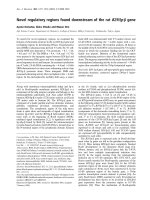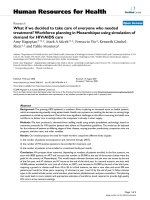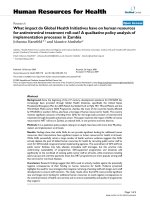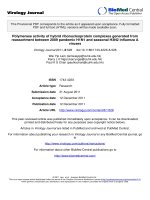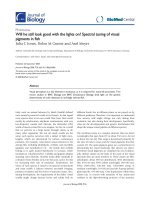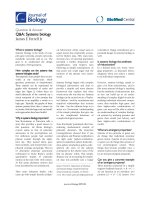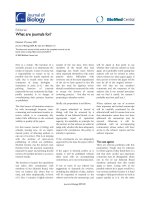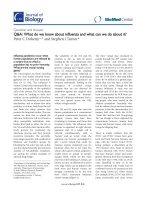Báo cáo sinh học: " What have we found out about the influenza A (H1N1) 2009 pandemic virus" doc
Bạn đang xem bản rút gọn của tài liệu. Xem và tải ngay bản đầy đủ của tài liệu tại đây (62.62 KB, 4 trang )
Turner et al.: Journal of Biology 2009, 8:69
The 1918 pandemic influenza virus is said to
have started by causing relatively mild disease
in the summer but to have become more
severe in the winter. Do we know why, and
might influenza A (H1N1) 2009 do the same?
It is not clear precisely what changes resulted in the
increased severity of infection during the second wave of the
1918 Spanish influenza pandemic. Certainly the occurrence
of multiple waves of influenza infection in the same year is
unusual and one possibility is progressive adaptation of the
1918 Spanish influenza virus to its new human host [1].
Molecular analysis, for example, suggests that the virus that
emerged during the second wave in the Northern
hemisphere had undergone changes in the hemagglutinin
(HA) binding site that increased binding specificity for
human receptors [2]. This is presumed to have affected the
replicative capacity and, therefore, the pathogenicity of the
virus. The 1918 Spanish influenza virus also encoded a non-
structural 1 (NS1) protein capable of blocking interferon
production and thus prevention of viral replication by the
host [3]. Changes in the NS1 protein may also have
contributed to host adaptation and increased virulence [1].
Importantly, however, two of the features that account for
the virulence of the highly patho genic avian influenza A
(H5N1) viruses are not present either in the Spanish
influenza virus or in the current pandemic influenza A
(H1N1) 2009 virus [4]. These are a lysine at position 627 of
the polymerase basic subunit 2, and glutamic acid in
position 92 of NS1 that, at least in animal models of
infection, increase the replicative capacity of the virus and
block host inhibition of viral replication, respectively [5,6].
As the (H1N1) 2009 pandemic virus continues to spread,
the opportunities for adaptation that increases virulence in
the human host also increase, but the changes required for
such adaptation and for increased virulence are difficult to
predict and by no means inevitable [7].
What about the possibility that influenza A
(H1N1) might recombine with other more
virulent viruses?
There is some concern that co-circulation with seasonal
influenza A viruses during the winter, or with highly
pathogenic H5N1 viruses in countries where those viruses are
endemic, might lead to the emergence of more virulent
reassortant viruses [8]. But although occasional dual
infections with pandemic and seasonal viruses have been
detected during the 2009 Southern hemisphere winter, there
have been no reports of emergence of such reassortants.
Might immunity built up in the course of the
Northern hemisphere summer lessen the
impact of the pandemic in the winter?
Those people who have already been infected with
influenza A (H1N1) 2009 are likely to have generated
antibody and T cell responses that will provide some level
of protection against this virus for the coming Northern
hemisphere winter, even if immune escape (‘antigenic
drift’) variants begin to emerge. There is no evidence so far
for such mutants - that is, mutants in which the antibody
binding sites in the HA have changed to escape recognition
by specific antibody. The likely explanation for the absence
of antigenic drift to date is that the proportion of immune
individuals in the community is still too low to drive the
selection of such mutants. This suggests that, despite the
large number of people who have been infected, and
serological and epidemiological evidence that older people
are relatively protected [9,10], the number of susceptible
individuals remains very high. Use of influenza A (H1N1)
2009 vaccines will be the most important approach to
lessening the impact of the pandemic this coming winter in
those countries that have access to them. Clinicians will also be
able to draw on early international experience in the manage-
ment of severe cases to reduce morbidity and mortality.
Animal experiments indicate that influenza A
(H1N1) 2009 causes relatively severe disease,
yet the human disease has been reported as
generally relatively mild. How can this
discrepancy be explained?
First of all, although initial reports suggest that most
human cases of influenza A (H1N1) 2009 infection are
mild, particularly in the developed world, this is somewhat
Question & Answer
Q&A: What have we found out about the influenza A (H1N1) 2009
pandemic virus?
Stephen J Turner*, Lorena E Brown*, Peter C Doherty*
†
and Anne Kelso
‡
Addresses: *Department of Microbiology and Immunology,
The University of Melbourne, Parkville, Victoria, 3010, Australia.
†
Department of Immunology, St Jude Childrens Research Hospital,
332 Nth Lauderdale, Memphis, TN 38105, USA.
‡
WHO
Collaborating Centre for Reference and Research on Influenza,
10 Wreckyn Street, North Melbourne, Victoria, 3051, Australia.
Correspondence: Stephen J Turner. Email:
69.2
Turner et al.: Journal of Biology 2009, 8:69
misleading as the symptoms are generally reminiscent of
those observed with seasonal influenza infection (fever
associated with upper respiratory tract illness) and even
seasonal influenza is estimated to cause 250,000 to
500,000 deaths worldwide each year. Second, up to 40% of
infected individuals present with vomiting and gastro-
intestinal (GI) symptoms, which is higher than for seasonal
influenza, and while there is no evidence as yet, this may be
indicative of more extensive viral replication. This is actually
consistent with three recent studies on the pathogenesis and
transmission of influenza A (H1N1) 2009 in ferret models of
infection [8,11,12]. All three studies showed that the
pandemic strains exhibit more extensive replication in the
respiratory tract, particularly the lower respiratory tract, of
infected ferrets, as well as in mice [11,12], non-human
primates and pigs [11]. Moreover, Maines and colleagues
were able to isolate virus from the GI tract of infected ferrets,
suggesting an explanation for the increased incidence of GI
distress in infected people [12], although no virus has yet
been detected in the GI tract of human cases. All three
studies also showed that influenza A (H1N1) 2009 caused
more tissue damage in the lower respiratory tract than do
typical seasonal influenza strains.
So are you saying the human disease actually
isn’t mild?
In some cases, certainly it isn’t. It is important to note that the
(H1N1) 2009 virus does cause severe infection in some people,
including those who are otherwise healthy. While some fatal
cases have been attributed to secondary bacterial infections or
exacerbation of other health conditions, as is commonly seen
in fatal cases of seasonal influenza in the elderly, an unusual
feature of influenza A (H1N1) 2009 infection is severe viral
pneumonitis, leading to acute respiratory distress syndrome,
prolonged stays in intensive care units and extended use of
mechanical ventilation or extracorporeal membrane oxygena-
tion (ECMO) [13,14]. It is unclear what predisposes some
people to mild versus severe complications.
And the tissue damage shown in the animal
experiments? Isn’t that also indicative of
severity?
That is not clear for humans. Although the animal experi-
ments show that influenza A (H1N1) 2009 infection causes
more extensive tissue damage than seasonal influenza
infection, this could be relatively minor in humans, possibly
because of the relatively low binding affinity of the influenza
A (H1N1) 2009 viral HA for human receptors. Human
influenza viruses bind their target cells through recognition
by the viral HA of cell surface glycoproteins that have sialic
acid moieties linked to galactose in a α2,6 configuration.
When Maines and colleagues used a glycan array to compare
glycan binding of HAs from influenza A (H1N1) 2009 and
1918 Spanish influenza [12], both showed the same binding
specificity and pattern, but the influenza A (H1N1) 2009 HA
bound with lower affinity than did the 1918 virus HA. This
was attributed to amino acid differ ences in the HA binding
site. Lower binding affinity could affect the degree of
inflammation and pathology caused by (H1N1) 2009
infection, so that although the virus seems to cause more
tissue damage, the pathology may not be as extensive as that
seen in infection with the more virulent 1918 Spanish
influenza virus or highly pathogenic H5N1 viruses.
Could the severe cases be caused by distinct
variants of the virus?
It seems not: to date, viruses isolated from such patients
have been indistinguishable from those isolated from
mild cases.
There are, however, two recent findings that may help
explain the increased pathogenesis in experimental animal
models and the severe complications in a small number of
infected people. The first is that in non-human primates
influenza A (H1N1) 2009 can infect and replicate in type II
pneumocytes, a cell type that is found in the lower respira-
tory tract, where the cells, as well as expressing α2,6-linked
sialic acid sequences, also express small amounts of α2,3-
linked sialic acid in humans [15]. Second, it has recently
emerged that influenza A (H1N1) 2009 HA has dual
specificity for α2,6-linked and a range of α2,3-linked sialic
acid sequences [16]. These findings suggest that the
increased virulence of the influenza A (H1N1) 2009 virus,
relative to seasonal influenza, and its capacity to cause
severe disease in a small number of individuals, may be
linked to an increased likelihood of replication within the
lower respiratory tract.
What do we know about the transmissibility
of influenza A (H1N1) 2009?
Modeling based on known global spread of influenza A
(H1N1) 2009 from Mexico suggests the virus is more
transmissible than seasonal influenza and has equivalent
transmissibility to that estimated for previous pandemics
[17]. Of particular interest is the rapid export of infections
from Mexico due to international travel. There was a high
correlation between international travel out of Mexico and
reported cases of (H1N1) 2009 infection in other countries
[17] until community transmission in other countries, such
as the USA and Australia, led to spread from those sites.
Animal models, however, have produced conflicting data
on the efficiency of aerosol transmission. Using an influ-
enza A (H1N1) 2009 strain isolated in The Netherlands,
Munster and colleagues demonstrated efficient aerosol
transmission between infected ferrets and contact ferrets
[8], whereas Maines and colleagues, using strains from the
Mexican and Californian outbreaks, demonstrated inefficient
aerosol transmission [12]. Itoh and colleagues on the other
hand, using the same Californian strain, were able to
demonstrate aerosol transmission [11]. While the reasons
for this discrepancy are unclear, it is notable that infection
69.3
Turner et al.: Journal of Biology 2009, 8:69
with the Dutch virus induced sneezing in the ferrets,
whereas Maines and colleagues did not report sneezing after
infection with the Mexican and Californian strains. Certainly
evidence of transmission in both the Dutch and Japanese
studies correlates with modeling that suggests the pandemic
(H1N1) 2009 virus is efficiently transmitted [17].
Are there indications that mutants of
influenza A (H1N1) 2009 are emerging that
may affect immunity, transmissibility or
sensitivity to antiviral drugs?
At this stage, little variation has been reported among any
of the (H1N1) 2009 strains isolated since April 2009. No
mutations have been identified in the HA that would be
expected to affect binding to antibodies or affinity for α2,6
sialic acid receptors. As noted above, this is likely to reflect
the absence of sufficient population immunity to drive the
selection of variants. Given how easily the influenza virus
mutates, it is only a matter of time before this happens.
The antiviral drug zanamivir (Relenza) has been used in
only a limited way for the control of (H1N1) 2009 and
resistance to this drug has not yet been detected among
pandemic viruses. By contrast, oseltamivir (Tamiflu) has
been used for treatment and prophylaxis on an unprece-
dented scale since the beginning of the outbreak. To date, 22
oseltamivir-resistant pandemic viruses have been reported,
mostly from individuals who had received the lower
prophylactic dose of the drug. All of these viruses contain
the His275Tyr mutation in the neuraminidase protein that is
known to confer oseltamivir resistance. Fortunately, there is
no direct evidence as yet for trans mission of resistant viruses
to untreated contacts. This differs from the situation among
seasonal A (H1N1) influenza viruses in which a strain with
the His275Tyr mutation began to spread among untreated
individuals in or before late 2007 [18] and has since become
the domi nant variant of that subtype circulating worldwide.
The fact that an oseltamivir-resistant strain could acquire
the ability to out-compete sensitive viruses, even if this does
not usually occur, has raised concern that such a variant
could also emerge among pandemic H1N1 viruses.
Acknowledgements
This work was funded by Australian NHMRC grants awarded to SJT,
LEB and PCD; a National Institutes of Health RO1 grant (AI170251)
awarded to PCD and The American Lebanese Syrian Associated
Charities (ALSAC) at St Jude Children’s Research Hospital (PCD).
The Melbourne WHO Collaborating Centre for Reference and
Research on Influenza is supported by the Australian Government
Department of Health and Ageing. SJT is an Australian Pfizer Senior
Research Fellow.
Where can I find out more?
WHO – Pandemic (H1N1) 2009 [ />swineflu/en/index.html]
CDC 2009 H1N1 Flu [ />1. Taubenberger JK: The origin and virulence of the 1918
“Spanish” influenza virus. Proc Am Philos Soc 2006, 150:86-
112.
2. Tumpey TM, Maines TR, Van Hoeven N, Glaser L, Solórzano
A, Pappas C, Cox NJ, Swayne DE, Palese P, Katz JM, García-
Sastre A: A two-amino acid change in the hemagglutinin of
the 1918 influenza virus abolishes transmission. Science
2007, 315:655-659.
3. Geiss GK, Salvatore M, Tumpey TM, Carter VS, Wang X,
Basler CF, Taubenberger JK, Bumgarner RE, Palese P, Katze
MG, García-Sastre A: Cellular transcriptional profiling in
influenza A virus-infected lung epithelial cells: the role of
the nonstructural NS1 protein in the evasion of the host
innate defense and its potential contribution to pandemic
influenza. Proc Natl Acad Sci U S A 2002, 99:10736-10741.
4. Neumann G, Noda T, Kawaoka Y: Emergence and pandemic
potential of swine-origin H1N1 influenza virus. Nature 2009,
459: 931-939.
5. Salomon R, Franks J, Govorkova EA, Ilyushina NA, Yen HL,
Hulse-Post DJ, Humberd J, Trichet M, Rehg JE, Webby RJ,
Webster RG, Hoffmann E: The polymerase complex genes
contribute to the high virulence of the human H5N1 influ-
enza virus isolate A/Vietnam/1203/04. J Exp Med 2006, 203:
689-697.
6. Seo SH, Hoffmann E, Webster RG: Lethal H5N1 influenza
viruses escape host anti-viral cytokine responses. Nat Med
2002, 8:950-954.
7. Morens DM, Taubenberger JK: Understanding influenza
backward. JAMA 2009, 302:679-680.
8. Munster VJ, de Wit E, van den Brand JM, Herfst S, Schrauwen
EJ, Bestebroer TM, van de Vijver D, Boucher CA, Koopmans
M, Rimmelzwaan GF, Kuiken T, Osterhaus AD, Fouchier RA:
Pathogenesis and transmission of swine-origin 2009
A(H1N1) influenza virus in ferrets. Science 2009, 325:481-
483.
9. (CDC) Centers for Disease Control and Prevention: Serum
cross-reactive antibody response to a novel influenza A
(H1N1) virus after vaccination with seasonal influenza
vaccine. MMWR Morb Mortal Wkly Rep 2009, 58:521-524.
10. Kelly H, Grant K: Interim analysis of pandemic influenza
(H1N1) 2009 in Australia: surveillance trends, age of infec-
tion and effectiveness of seasonal vaccination. Euro
Surveill 2009, 14.pii:19288.
11. Itoh Y, Shinya K, Kiso M, Watanabe T, Sakoda Y, Hatta M,
Muramoto Y, Tamura D, Sakai-Tagawa Y, Noda T, Sakabe S,
Imai M, Hatta Y, Watanabe S, Li C, Yamada S, Fujii K,
Murakami S, Imai H, Kakugawa S, Ito M, Takano R, Iwatsuki-
Horimoto K, Shimojima M, Horimoto T, Goto H, Takahashi K,
Makino A, Ishigaki H, Nakayama M, et al.: In vitro and in vivo
characterization of new swine-origin H1N1 influenza
viruses. Nature 2009, 460:1021-1025.
12. Maines TR, Jayaraman A, Belser JA, Wadford DA, Pappas C,
Zeng H, Gustin KM, Pearce MB, Viswanathan K, Shriver ZH,
Raman R, Cox NJ, Sasisekharan R, Katz JM, Tumpey TM:
Transmission and pathogenesis of swine-origin 2009
A(H1N1) influenza viruses in ferrets and mice. Science
2009, 325:484-487.
13. (CDC) Centers for Disease Control and Prevention: Intensive-
care patients with severe novel influenza (H1N1) virus
infection - Michigan. MMWR Morb Mortal Wkly Rep 2009, 14:
19288.
14. Kaufman MA, Duke GJ, McGain F, French C, Aboltins C, Lane
G, Gutteridge GA: Life-threatening respiratory failure from
H1N1 influenza 09 (human swine influenza). Med J Aust
2009, 191:154-156.
15. Shinya K, Ebina M, Yamada S, Ono M, Kasai N, Kawaoka Y:
Avian flu: influenza virus receptors in the human airway.
Nature 2006, 440:435-436.
16. Childs RA, Palma AS, Wharton S, Matrosovich T, Liu Y, Chai
W, Campanero-Rhodes MA, Zhang Y, Eickmann M, Kiso M,
Hay A, Matrosovich M, Feizi T: Receptor-binding specificity
of pandemic influenza A (H1N1) 2009 virus determined by
carbohydrate microarray. Nat Biotech 2009, 27:797-799.
17. Fraser C, Donnelly CA, Cauchemez S, Hanage WP, Van
Kerkhove MD, Hollingsworth TD, Griffin J, Baggaley RF,
Jenkins HE, Lyons EJ, Jombart T, Hinsley WR, Grassly NC,
69.4
Turner et al.: Journal of Biology 2009, 8:69
Balloux F, Ghani AC, Ferguson NM, Rambaut A, Pybus OG,
Lopez-Gatell H, Alpuche-Aranda CM, Chapela IB, Zavala EP,
Guevara DM, Checchi F, Garcia E, Hugonnet S, Roth C; WHO
Rapid Pandemic Assessment Collaboration: Pandemic poten-
tial of a strain of influenza A (H1N1): early findings. Science
2009, 324:1557-1561.
18. Meijer A, Lackenby A, Hungnes O, Lina B, van-der-Werf S,
Schweiger B, Opp M, Paget J, van-de-Kassteele J, Hay A,
Zambon M; European Influenza Surveillance Scheme:
Oseltamivir-resistant influenza virus A (H1N1), Europe,
2007-08 season. Emerg Infect Dis 2009, 15:552-560.
Published: 18 September 2009
doi:10.1186/jbiol179
© 2009 BioMed Central Ltd

